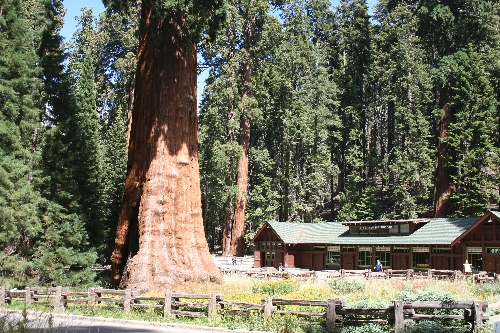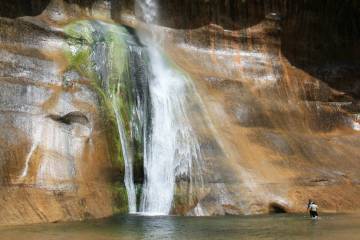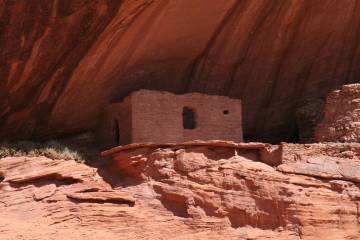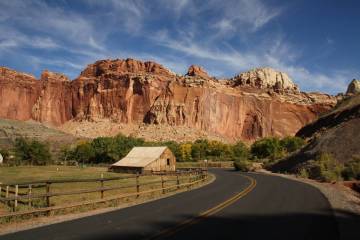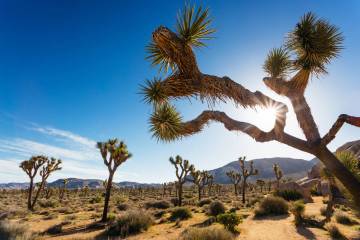Sequoia National Park a must-see in high summer
If you have a few days and dollars this summer to invest, you can get much for your money and time at Sequoia and Kings Canyon national parks in California. In these adjacent and jointly managed parks about six hours from Las Vegas, you can wander among the largest trees on earth, hike some of the 850 miles of maintained trail, swim in cool snow-fed mountain streams and maybe see a black bear or three.
The giant sequoia trees, of course, are the parks' star attractions. By most definitions, they are the largest trees on earth, and some you might see are as tall as a 26-story building and between 1,800 and 2,700 years old. They usually grow at an elevation between 5,000 and 7,000 feet on the west slope of the Sierra.
Sequoia's Giant Forest area is a good place to start any visit. The grove includes four out of the world's five largest sequoias, including the General Sherman Tree. That tree is estimated to be more than 2,000 years old and weighs about 2.7 million pounds. You can't wrap your arms around this tree, for its circumference at the base is more than 100 feet. It is even challenging to photograph because it's 275 feet tall, and it's hard to get the whole tree into the picture.
The Giant Forest area is also home to Moro Rock, a must-do hike up a granite monolith. The trail, which climbs narrow manmade steps, is only about a quarter-mile long and has an elevation gain of about 300 feet. The views from Moro are some of the best in the park on a day hike. From the top looking east, you will see the Great Western Divide, a high-elevation granite mountain chain that runs through the center of the park.
Near Moro Rock is Crescent Meadow. When naturalist John Muir visited in 1875, he thought this meadow so beautiful, he named it "The Gem of the Sierra." There is an easy 1.6-mile loop trail around the sequoia-bordered meadow, and in late July and early August, the meadow is often carpeted with wildflowers, a spectacular sight to see.
Sequoia was created in 1890, making it the second-oldest national park in the United States, preceded only by Yellowstone in 1872. No matter which U.S. national park you are in, you will find that all the park rangers wear uniform belts embossed with sequoia cones.
The parks' elevations range from 1,360 feet to 14,494, so there is a great disparity in temperatures depending on where you are. If you spend most of your time where the giant sequoias are, you will find daily high temperatures in the 70s in July and August. Although the parks remain open year-round, the season is generally May to September because snow comes early in these parts.
Seeing a black bear foraging for berries along the roadside is an exciting experience for most people and quite common in summer. This time of year, you might also see a pair of cubs with their mom. On my last visit, we not only encountered such a family of three but also saw several other bears apparently living the single life. When you enter the park, be sure to stop at the visitor center and get information about bear safety.
Lodging in Sequoia is limited to the Wuksachi Lodge, but in neighboring Kings Canyon, there are the Grant Grove Cabins, John Muir Lodge and Cedar Grove Lodge. Other lodging is available in Three Rivers, just outside the Foothills entrance to Sequoia. If you are traveling from Las Vegas, you will drive through Three Rivers. There are also 14 campgrounds between the two parks; the majority of sites are on a first-come, first-served basis. Lodgepole, Dorst and some group campgrounds are open to reservations. For lodging or camping reservations or for further information about the park, visit the park website at nps.gov/seki, or call 559-565-3341.
Deborah Wall is the author of "Great Hikes, A Cerca Country Guide" and "Base Camp Las Vegas: Hiking the Southwestern States," published by Stephens Press. She can be reached at deborabus@aol.com.
Directions
From Las Vegas, take Interstate 15 south for 160 miles to Barstow, Calif. Exit onto CA-58 and drive north 126 miles. Merge onto CA-99 and go north for 64 miles. Exit to CA-137 east and drive 11 miles to CA-65/CR-J27. Continue for eight miles, turning right onto CA-198 east and following for about 26 miles to the Sequoia National Park entrance.



